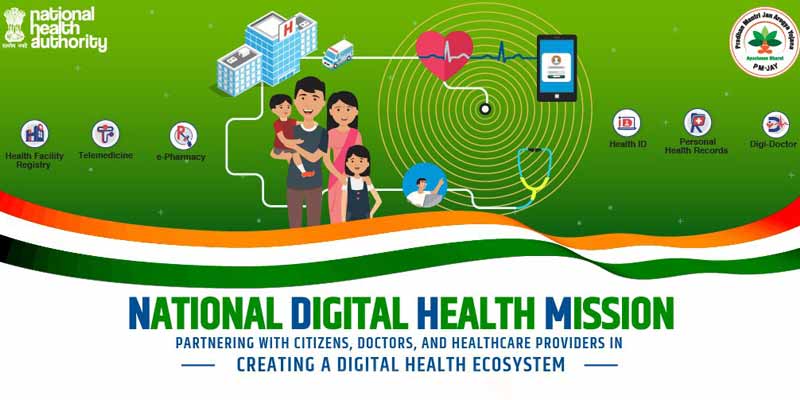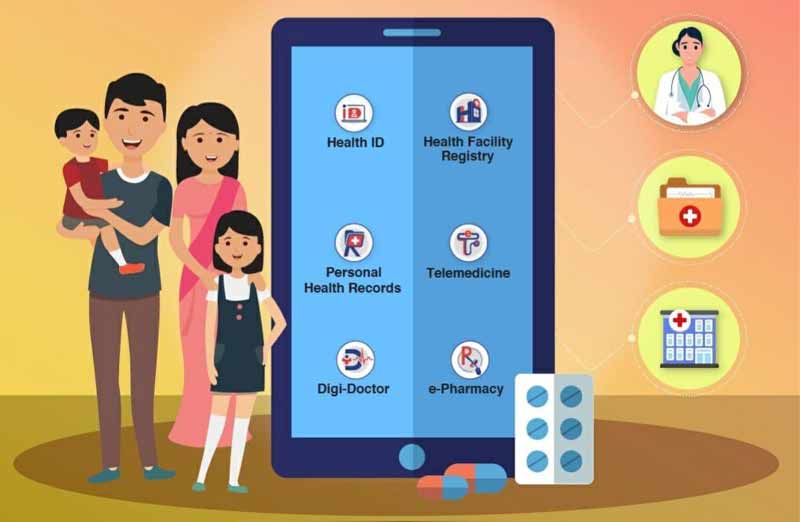- India
- Aug 16
National Digital Health Mission may transform health sector
Prime Minister Narendra Modi unveiled National Digital Health Mission (NDHM) under which every Indian will get a health ID that will ease access to medical services.
In his Independence Day address, Modi said the health ID will store every individual’s medical records and the mission will herald a new revolution in the health sector.
The mission is expected to bring efficiency and transparency in health care services in the country. It will help reduce problems in getting treatment with the help of technology.
What is NDHM?
The NDHM is a holistic, voluntary health care programme that will reduce the existing gap between various stakeholders such as doctors, hospitals and other health care providers, pharmacies, insurance companies, and citizens by bringing them together and connecting them in an integrated digital health infrastructure
It was rolled out on a pilot mode in six Union Territories — Chandigarh, Ladakh, Dadra and Nagar Haveli and Daman and Diu, Puducherry, Andaman and Nicobar Islands and Lakshadweep. Based on the initial learnings in the UTs, the government will gradually work in partnership with the states to launch the NDHM.
The National Health Authority (NHA), the apex central government agency responsible for the implementation of Ayushman Bharat Pradhan Mantri Jan Arogya Yojana, has been given the mandate by the government to design, build, rollout and implement the mission in the country.
What are the components of NDHM?
The NDHM comprises several key building blocks or digital systems that will enable access to timely, safe and affordable healthcare through a ‘citizen-centric’ approach.
1) Health ID: Every patient who wishes to have their health records available digitally must start by creating a Health ID. Each Health ID will be linked to a health data consent manager which will be used to seek the patient’s consent and allow for seamless flow of health information from the Personal Health Records module. Health ID is created by using basic details and Mobile Number or Aadhaar Number. It will be used for the purposes of uniquely identifying persons, authenticating them, and threading their health records (only with the informed consent of the patient) across multiple systems and stakeholders.
2) Digi-Doctor: It is a comprehensive repository of all doctors practicing or teaching modern/ traditional systems of medicine. Enrolling on Digi-Doctor is completely voluntary and enables doctors to get connected to India’s digital health ecosystem.
3) Health Facility Registry: It is a comprehensive repository of health facilities of the country across different systems of medicine. It includes both public and private health facilities including hospitals, clinics, diagnostic laboratories and imaging centers, pharmacies, etc. It is a key building block needed to support the unified digital health ecosystem of the country.
4) Personal Health Records: It is an electronic record of health-related information on an individual that conforms to nationally recognised interoperability standards and that can be drawn from multiple sources while being managed, shared, and controlled by the individual. The most salient feature of the PHR is that the information it contains is under the control of the individual. The functions that are supported by a Personal Health Record-System (PHR) are those that enable an individual to manage information about his or her healthcare.
5) Electronic Medical Record (EMR): It is a digital version of a patient’s treatment history from a single facility. The health information recorded in a facility is stored locally at the facility where the patient was registered. The web EMR application is an easy to use application with minimal functions but sufficient enough to capture important clinical details about the patient’s care in a facility.
Other two components are e-Pharmacy and telemedicine. All of these systems, except e-Pharmacy and telemedicine, have been deployed and are up and running.
How did the concept of NDHM originate?
The National Health Policy (NHP) 2017 has the following goal:
“The attainment of the highest possible level of health and wellbeing for all at all ages, through a preventive and promotive health care orientation in all developmental policies, and universal access to good quality health care services without anyone having to face financial hardship as a consequence.”
In a follow-up of the NHP’s specific goals for adopting digital technologies, the ministry of health and family welfare constituted a committee headed by J. Satyanarayana to develop an implementation framework for the National Health Stack. This committee produced the National Digital Health Blueprint (NDHB), laying out the building blocks and an action plan to comprehensively and holistically implement digital health.
Taking forward the NDHB, this document describes the broad context, rationale, scope, and implementation arrangements for a digital ecosystem for health care services across the country. Since the implementation is envisioned to be in a mission mode, the initiative is referred to as the National Digital Health Mission (NDHM).
Objectives of the NDHM:
• Establish state-of-the-art digital health systems, to manage the core digital health data, and the infrastructure required for its seamless exchange.
• Establish registries at appropriate levels to create a single source of truth in respect of clinical establishments, health care professionals, health workers, drugs and pharmacies.
• Enforce adoption of open standards by all national digital health stakeholders.
• Create a system of personal health records, based on international standards, easily accessible to individuals and health care professionals and services providers, based on individual’s informed consent.
• Promote development of enterprise-class health application systems with a special focus on achieving the Sustainable Development Goals for health.
• Adopt the best principles of cooperative federalism while working with the states and UTs for the realisation of the vision.
• Ensure that the health care institutions and professionals in the private sector participate actively with public health authorities in the building of the NDHM, through a combination of prescription and promotion.
• Ensure national portability in the provision of health services.
• Promote the use of clinical decision support (CDS) systems by health professionals and practitioners.
• Promote a better management of the health sector leveraging health data analytics and medical research.
• Provide for enhancing the efficiency and effectiveness of governance at all levels.
• Support effective steps being taken for ensuring quality of health care.
• Strengthen existing health information systems, by ensuring their conformity with the defined standards and integration with the proposed NDHM.
How will it benefit the health sector?
• The implementation of NDHM is expected to significantly improve the efficiency, effectiveness, and transparency of health service delivery overall. Patients will be able to securely store and access their medical records (such as prescriptions, diagnostic reports and discharge summaries), and share them with health care providers to ensure appropriate treatment and follow-up. They will also have access to more accurate information on health facilities and service providers. Further, they will have the option to access health services remotely through tele-consultation and e-pharmacy. NDHM will empower individuals with accurate information to enable informed decision making and increase accountability of healthcare providers.
• NDHM will provide choice to individuals to access both public and private health services, facilitate compliance with laid down guidelines and protocols, and ensure transparency in pricing of services and accountability for the health services being rendered.
• Health care professionals across disciplines will have better access to patient’s medical history (with the necessary informed consent) for prescribing more appropriate and effective health interventions. The integrated ecosystem will also enable a better continuum of care.
• NDHM will help digitise the claims process and enable faster reimbursement. This will enhance the overall ease of providing services amongst the health care providers.
• Policy makers and programme managers will have better access to data, enabling more informed decision making by the government. Better quality of macro and micro-level data will enable advanced analytics, usage of health-biomarkers and better preventive health care. It will also enable geography and demography-based monitoring and appropriate decision making to inform design and strengthen implementation of health programmes and policies.
• Researchers will greatly benefit from the availability of such aggregated information as they will be able to study and evaluate the effectiveness of various programmes and interventions. NDHM would facilitate a comprehensive feedback loop between researchers, policymakers, and providers.
How technology will help in implementing NDHM?
The current strong public digital infrastructure — including that related to Aadhaar, Unified Payments Interface and wide reach of the Internet and mobile phones (JAM trinity) — provides a strong platform for establishing the building blocks of NDHM. The existing ability to digitally identify people, doctors, and health facilities, facilitate electronic signatures, ensure non-repudiable contracts, make paperless payments, securely store digital records, and contact people provide opportunities to streamline health care information through digital management.
Ayushman Bharat—Pradhan Mantri Jan Arogya Yojana (AB-PMJAY) has successfully used the available public digital infrastructure to provide end-to-end services through an information technology (IT) platform from identification of beneficiaries to their admission and treatment in hospitals to their discharge and paperless payment to hospitals. The experience of AB-PMJAY can be leveraged to expand the reach of digital health to all residents and develop an open and interoperable health management system that empowers residents, healthcare providers, the government and researchers.
Emerging technologies such as artificial intelligence, the internet of things (IoT), Blockchain and cloud computing provide additional opportunities for facilitating a more holistic digital health ecosystem, that can increase the equitable access to health services, improve health outcomes and reduce costs.


